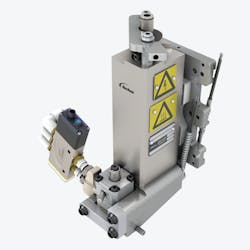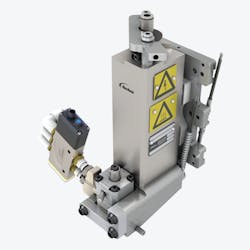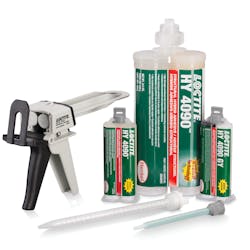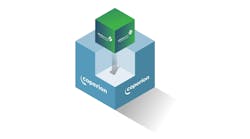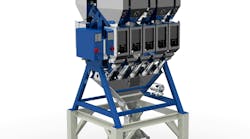NORDSON UPDATES DISPENSING SYSTEMS
Nordson’s new Unity PURJet dispensing systems are debuting this summer. The company’s PJ30XT and the PJ300XT models are designed to provide accurate, fast dispensing of heated PU adhesives and other heated materials in 30-milliliter (ml) syringes and 300-ml cartridges.
“The dispensers will help extend the useful life of the syringe to maximize material use and minimize waste,” said Terry Dunbar, global key account manager at Nordson. He explained that the dispensers allow the syringes to function with lower temperatures, which protects the syringes.
In addition to bonding plastic parts, the units can be used for sealing, gasketing and encapsulating a variety of materials. To improve accuracy and functionality, the dispensing systems can be combined with a tabletop automation system from Nordson known as the Unity, Dunbar said.
Dunbar said the new models present improvements over their predecessor.
“The PJ30XT and the PJ300XT replace the PJ30 model,” he said. “They offer more flexibility in jetting adhesives and better heat management. They also have fewer wear parts and therefore a lower cost of ownership than the PJ30.”
The XT in the name stands for extended technology.
“The improved technology includes dual heating zones with precise temperature controls in the applicators that preserve adhesive life by maintaining a lower temperature in the cartridge,” Dunbar said.
The new units offer non-contact dispensing that applies accurate amounts at high speeds; the ability to dispense discrete dots or a solid bead of adhesive; and patented jetting technology that places the adhesive without the need to adjust for a change in height of the substrate, the company said.
HENKEL'S LOCTITE ADHESIVES RECEIVE 2019 ASC INNOVATION AWARD
Henkel, a company that makes adhesives, won the Adhesives and Sealants Council 2019 innovation of the year award, with its entry of seven new adhesives and sealants under its Loctite brand. The Loctite universal structural bonders powered by hybrid technology includes the following products: HY 4090, HY 4090GY, HY 4080, HY 4080GY, HY 4060GY, HY 4070 and HY 4092GY.
The HY designation refers to hybrid and GY refers to the color gray. Products without the GY designation are off-yellow color.
The bonding agents are known as 2K adhesives — adhesives created by the uniform mixing of two separate ingredients. In the case of the Henkel products, the ingredients are an epoxy and a resin.
“The Loctite universal structural bonders are patented 2K technologies that are based on the formation of cyanoacrylate and epoxy or methacrylate polymers, which created a new, more robust category of 2K adhesives that offer faster cure, universal adhesion to many substrates and are safer to handle than many traditional structural bonders,” said Jamie Serenson, director of innovation management at Henkel. “Their adhesion to plastics is much higher than traditional 2K epoxies.”
The adhesives can be applied by hand, using 10-ml to 50-ml hand-held dual-cartridge dispensers, or by fully automated robots.
“The hand-held dual cartridges include an integrated plunger and a mix tip, so it comes out of the tube as a uniformly mixed product,” Serenson said. “OEM applications are typically applied by semi-automated or automated equipment from 400-ml tubes or pails.”
The adhesives work well on a wide variety of metals, plastics and elastomers. They have very strong adhesion to PC, PVC, polymethyl acrylate and ABS, according to Serenson.
“We are selling to 800 different industry codes directly and through our distribution network,” he said. “They are well-suited for many industries including auto, aerospace, consumer, packaging and electronics. Several of the products are ISO-10993 approved for medical applications.”
Henkel offers a Design Guide for Bonding Plastics to help customers select the right product for their application. The 96-page manual addresses how the many different adhesives adhere to different materials, their bonding strengths and advantages and disadvantages.
“This is a valuable tool to those who want to bond plastics,” Serenson said. “It was launched in 1995 and is updated often with new adhesives and plastics. We also have a guide for bonding rubber and thermoplastic elastomers.”
Henkel offers four types of robots that can apply the adhesives automatically.
“Our primary charter is to develop new solutions for customers. We try to own the whole ecosystem around that,” Serenson said. “We make valves, curing lights and Loctite-branded robots. We design and build robots, which are available from Henkel and through our distributors.”
ND INDUSTRIES ADHESIVE BONDS LOW-SURFACE-ENERGY PRODUCTS
PB500, a new adhesive from ND Industries, the parent company of Vibra-Tite, bonds low- surface-energy products, such as HDPE, PP, polytetrafluoroethylene (PTFE) and other engineered plastics, senior research chemist Norman Rawls said.
Low-surface-energy materials have weak intermolecular forces at the surface and do not bond well to other materials.
“PB500 joins our structural acrylic line of adhesives, but it stands alone for this use,” Rawls said. “It was developed to meet a general industry need, not for a specific customer.” The product was in development for about six months before its introduction in the first quarter of this year.
“General-grade adhesives have a problem bonding to lower-surface-energy materials because there is minimal chemical reaction between the substrate and adhesive,” Rawls said. “Low-surface-energy plastics are those that have a surface energy of 40 dynes or under.”
An example of a low-surface-energy material is PTFE — better known by its brand name, Teflon. It doesn’t bond easily with other materials. On the other hand, a plastic with a higher surface energy, such as PC, more easily bonds to other materials.
“The advantage of PB500 is that it can bond either of these materials, and many others, without needing extra surface preparation to either of the materials before bonding them,” he said. “It offers the user increased working time while building a high-strength bond faster than other adhesives in its class.”
PB500 also offers high impact resistance and can cure at room temperature. At temperatures warmer than 80 degrees Fahrenheit, PB500 will cure even more quickly.
PB500 is a two-part methacrylate-based adhesive that is made of two products — an activator and a resin — that are inert until they are mixed together. The adhesive can be applied using dual-chamber cartridges with a static mix tip. The mixing element is in the tip of the nozzle, designed to ensure that users get the right mix of activator and resin with each use.
While PB500 is most often sold in 400-ml cartridges to parts manufacturers, it also is available in larger quantities, such as 5-gallon pails or larger drums. The larger sizes may be preferred by companies that set up an automated assembly operation with a robot. It can be purchased directly from ND Industries or through authorized distributors.
Bruce Adams, senior staff reporter
Contact:
Henkel Corp.,
Bridgewater, N.J., 908-685-7000, www.henkel-northamerica.com
ND Industries Inc.,
Clawson, Mich., 248-288-0000, www.ndindustries.com
Nordson Corp.,
Westlake, Ohio, 440-892-1580, www.nordson.com/en
